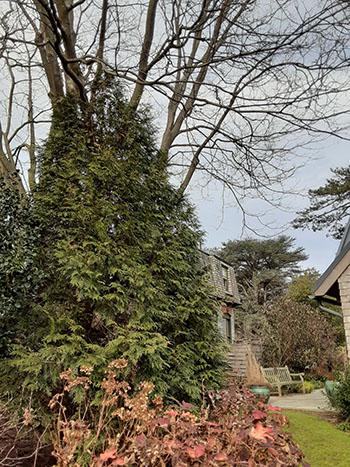
Plant of the Month: Thuja spp.
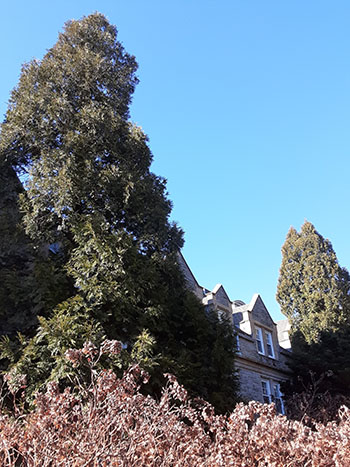
Thuja occidentalis are typically narrow pyramidal but can develop a broad span with time. photo credit: R. Payne-Meyer
Sometimes plants take a while to grow on me, and sometimes plants I previously disliked I come to really like. Such is the case with the Thuja genus. Woody plant expert Michael Dirr calls Thuja occidentalis (eastern arborvitae) “as common as grass,” and my expectation for T. occidentalis trees in the landscape are typically low as the grass on the putting green. I would submit that the all too common browned out and humdrum spire-type cultivars of T. occidentalis belie the true dignity of this genus. These soft-textured conifers deserve some praise.
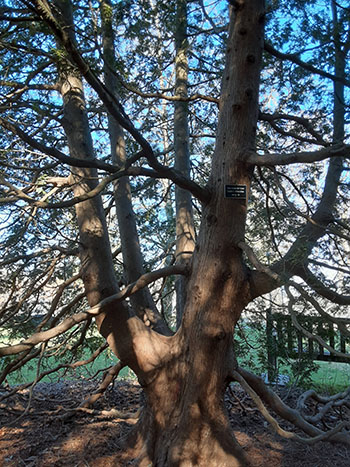
The zany low-armed branching of mature Thuja occidentalis specimens is easy to love. photo credit: R. Payne-Meyer
Make no mistake, the untamed and crooked form of a cliffside Thuja occidentalis can be awe- inspiring. I have the greatest respect for the beauty of plants in their natural setting. A straight species T. occidentalis, though irregular, is usually handsome to my eye. Plants are typically narrow pyramidal but can develop a broad span with time. The zany low-armed branching of mature specimens is easy to love. Two grand specimens of the straight species anchor the northeast side of Wharton Hall, showcasing the potential majesty of this tree.
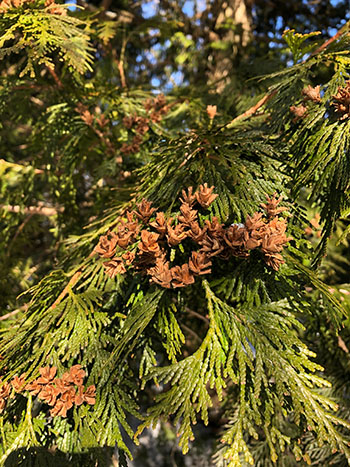
Dark sprays of ferny foliage with cones on Thuja plicata ‘Atrovirens’. photo credit: J. Coceano
When visiting the Pacific Northwest, I was delighted by the grace and dignity of wild-growing Thuja plicata, the western arborvitae. These mammoths are the largest of the cypress family (Cupressaceae), growing to 70’ in the landscape and up to 200’ in the wild. Dark sprays of ferny foliage and a slender conical shape make this plant proud and proper. Dirr calls the foliage the most beautiful of all the arborvitaes. Unlike its cousin T. occidentalis, commercial varieties of this plant hold up just as well in the garden as in nature, and don’t suffer from unattractive winter discoloration. T. plicata ‘Excelsa’ is a smaller selection that shares the grace and dense habit of species, and is great for a coniferous screen in limited space. T. plicata ‘Zebrina’ is a stellar selection offering subtle golden variegation.
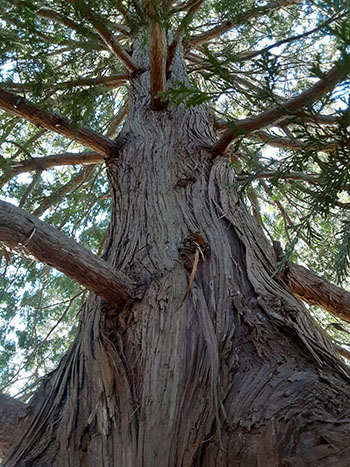
These mammoths, Thuja plicata, are the largest of the cypress family (Cupressaceae), growing to 70’ in the landscape and up to 200’ in the wild. photo credit: R. Payne-Meyer
The Korean arborvitae, Thuja koraiensis has dashing foliage as well: blue-green on top and white beneath. The contrast is sharp, but tough to see under the drooping foliage. T. koraiensis is shrubby and grows slowly. The form is broad and gracefully pyramidal. Plants grow approximately 15’ in height, but can reach 30’. T. koraiensis ‘Glauca Prostrata’ is a prostrate form that makes a great substitute for Microbiota decussata, the Russian arborvitae. This form is boosted by an elevated site, such as above a wall, where the silvery foliage can be shown off.
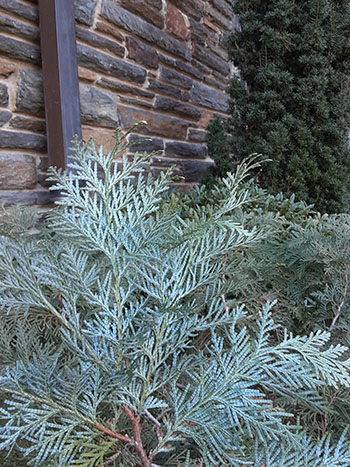
The Korean arborvitae, Thuja koraiensis has dashing foliage as well: blue-green on top and white beneath. photo credit: R. Payne-Meyer
The Japanese arborvitae, T. standishii, is also a smaller- statured conifer, growing a bit larger than T. koraiensis in the landscape, but much larger in the wild. Arched branches with flattened sprays of droopy foliage provide a weeping effect. A hybrid between T. plicata and T. standishii, Thuja ‘Green Giant’, is widespread in the plant industry and is more worthy than the equally ubiquitous T. occidentalis selections. These plants form a perfect conical shape and have an extraordinary growth rate.
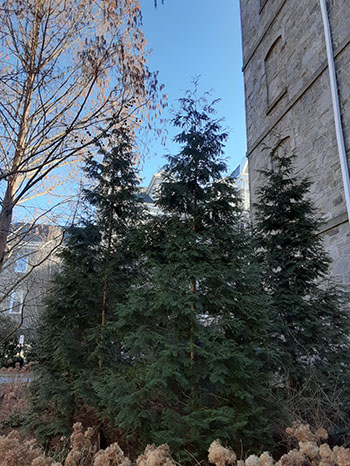
While T. ‘Green Giant’ makes an attractive specimen tree, it is most commonly used for screening and hedging. photo credit: R. Payne-Meyer
While T. ‘Green Giant’ makes an attractive specimen tree, it is most commonly used for screening and hedging. This selection boasts better disease resistance than Leyland cypress (×Cuprocyparis leylandii) and better deer resistance than T. occidentalis.
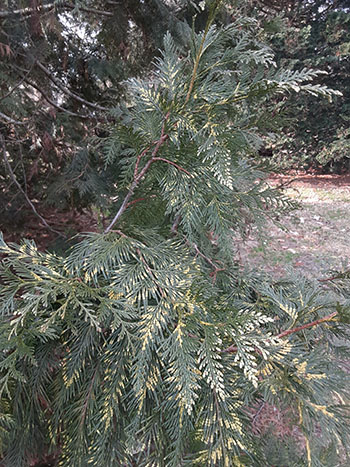
T. plicata ‘Zebrina’ is a stellar selection offering subtle golden variegation. photo credit: R. Payne-Meyer
Thuja sutchuenensis (Sichuan arborvitae) is the fifth and final species of Thuja, a tree rare in horticulture, and nearly extinct in the wild. This is a tree I would hope to see welcomed into the Arboretum collection in the future.
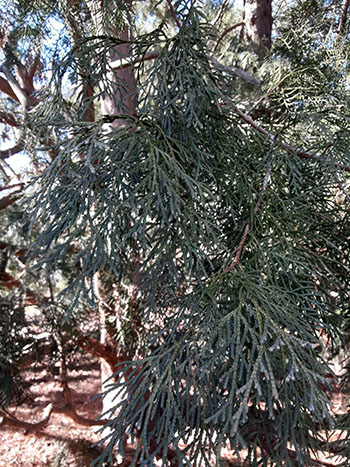
The Japanese arborvitae, T. standishii, is also a smaller- statured conifer, growing a bit larger than T. koraiensis in the landscape, but much larger in the wild. photo credit: R. Payne-Meyer
The aroma of Thuja spp. is a treat as well. The fibrous bark-with strips of tan, brown, red and orange- looks great and smells great crushed. The fruity aroma of the foliage is more noticeably aromatic yet. Add this to the numerous reasons I think this genus deserves another chance!

T. plicata ‘Excelsa’ is a smaller selection that shares the grace and dense habit of species, and is great for a coniferous screen in limited space. photo credit: R. Payne-Meyer





Inge Daniels
Posted at 10:11h, 21 JanuaryThanks for this beautifully described portrait of a tree we consider so humdrum. I’ll be looking at arborvitae with fresh eyes.